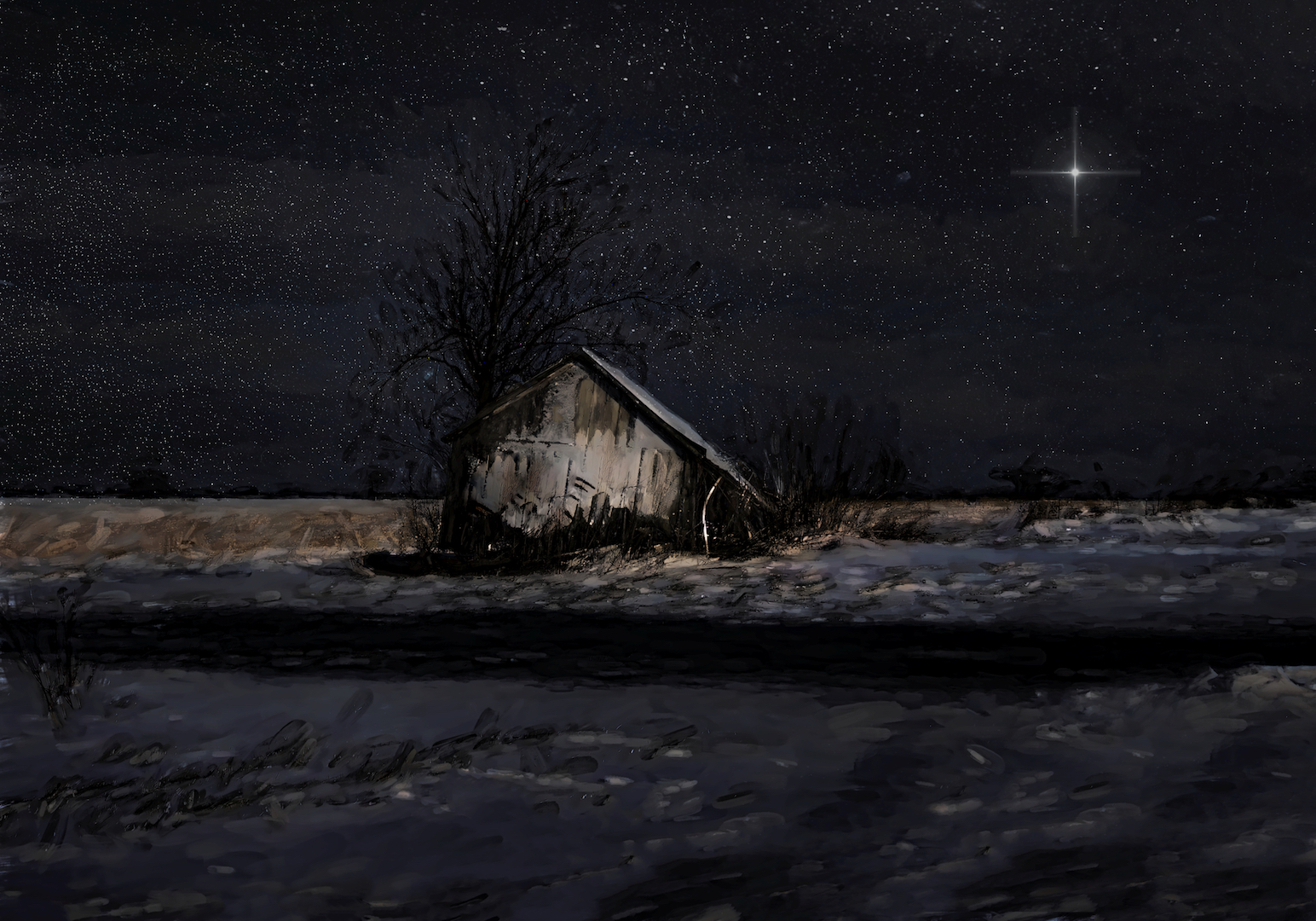What was the Star of Bethlehem?
Probably not a star.

As the well-known story in the Gospel of Matthew goes, three Magi, or wise men, followed the Star of Bethlehem to Jerusalem some 2,000 years ago. And after consulting with King Herod of Judea, the men found newborn baby Jesus in the little town of Bethlehem. Whether such an event really happened in history is difficult to prove, but if it did, what was the Star of Bethlehem?
This is a question scholars have long pondered, not just from a religious or historical perspective, but from a scientific one, too. Plenty of theories have been proposed, from an astronomical event to an astrological horoscope, but thanks to modern astronomy, scientists are getting closer to an answer.
"If what is in the New Testament is a historical account of something, then that historical account requires an explanation," David Weintraub, a professor of physics and astronomy at Vanderbilt University in Tennessee, told All About Space in an email. "As an astronomer, you want an astronomical explanation."
Related: As heavenly bodies converge, many ask: Is the Star of Bethlehem making a comeback?
The Star of Bethlehem wasn't a comet or a supernova
We know that Halley's Comet was visible in the sky in 11 B.C. However, as the Magi trekked toward Jerusalem and on to Bethlehem, it seems unlikely that they followed a comet because its position would have changed as the Earth rotated, so the comet would not have led them in a single direction. What's more, in the ancient world, comets were often regarded as bad omens.
"For Christmas cards, it makes a nice picture having a comet and a tail but in those days comets up in the sky were usually a harbinger of impending disaster," Grant Mathews, a professor of theoretical astrophysics and cosmology at the University of Notre Dame in Indiana, told All About Space in an email.
Related: Was the Star of Bethlehem a star, comet … or miracle?
We can also rule out novas and supernovas. Either event would have resulted in a detectable remnant, but astronomers have not found anything that might date back to this time.
Furthermore, had the Magi followed one, they probably would have walked in a circle. "You can't follow a star from Baghdad to Jerusalem to Bethlehem," Weintraub said. "Stars don't do that. They rise and set, and they don't sit in the sky."
Such an event would surely have been seen by others at the time, too. Although novas are reportedly quite rare, you'd still expect to find other historical accounts of a large, bright event in the sky.
Other theories suggest a supernova in the Andromeda galaxy as the cause, as described in a 2005 study published in journal The Observatory. Although it's possible to see the galaxy with the unaided eye, it wouldn't have been possible to see a star going supernova and exploding within it — even with the help of a telescope.
Related: Best telescopes 2020: Top picks for beginners, viewing planets, astrophotography and all-arounders

The "star" could have been an entire sky of stars
This leads us to one of two possibilities. The first is that the Magi were making an astrological interpretation of the sky. The fact that they needed to ask Herod for directions when they arrived suggests they were not being led to their final destination by a single bright object.
Astrology was widely used at the time, and with the Magi coming from Babylon, it's plausible that they were astrologers. And due to a particular alignment of planets and stars, they may have read a hidden meaning among the stars, leading them to King Herod. For example, Jupiter's display could have been of great significance here, as astrology associated the planet Jupiter with royalty, so the moon passing it in the constellation of Aries on April 17, 6 B.C. could have heralded the birth of Christ.
Related: Images: World's oldest astrologer's board
"Modern astronomers don't put any credence in astrology, but 'modern' is important in this context," Weintraub said. "What's important is what people thought 2,000 years ago. Astrology was a big deal back then. The explanation I have found that makes the most sense is that it was astrological."
Or, the "star" could have been a conjunction
The other, more astronomical explanation is that there was indeed a bright object in the sky — a conjunction between planets and stars. A conjunction occurs when two or more celestial bodies appear to meet in the night sky from our location on Earth. These events can continue every night in a similar location for days or weeks. If the wise men were to follow the moment of conjunction, it's possible they would have been led in a specific direction.
Related: 'Great conjunction' of Jupiter and Saturn will form a 'Christmas Star' on the winter solstice
Astronomer Michael Molnar suggested that a conjunction theory might be correct in his book "The Star of Bethlehem" (Rutgers University Press, 1999). If the "star" was the result of a conjunction (and this historical event did really happen), then there are a number of different alignments that could be the culprit.
Perhaps the most promising, and the one favored by Mathews, is an alignment of Jupiter, Saturn, the moon and the sun in the constellation of Aries on April 17, 6 B.C. This conjunction fits with the story for a few reasons. First, this conjunction happened in the early morning hours, which aligns with the Gospel's description of the Star of Bethlehem as a rising morning star. The Magi also lost sight of the star, before seeing it come to rest in the place where baby Jesus lay in the stable. This could have been the result of the retrograde motion of Jupiter, which means that it appears to change direction in the night sky as Earth's orbit overtakes it.
"Normally, planets move eastward if you're following them in the sky," Mathews said. "But when they go through retrograde motion, they turn around and go in the direction that the stars rise and set at night [westward]."
Two other conjunctions around a similar time also look promising. One is the meeting of Jupiter, Venus and the star Regulus in the constellation of Leo on June 17, 2 B.C. Without the aid of a telescope, the two planets would appear as a single "star," brighter than Venus and Jupiter individually. Another conjunction occurred in 6 B.C., between Jupiter, Saturn and Mars in the constellation of Pisces. But neither of these latter two conjunctions match the description in the New Testament as closely as the conjunction that occurred on April 17, 6 B.C.
The mystery persists
Although scientists have ruled out several possibilities, we may never know for sure what the Star of Bethlehem was or if it even really happened, barring some remarkable archaeological finding. But it's a question that comes up year after year, and it will continue to pique the interest of scientists and historians alike for many years to come.
"Nothing in science is ever case closed, nor is it in history," Mathews said. "We may never know if the Star of Bethlehem was a conjunction, astrological event or a fable to advance Christianity. Maybe it was simply a miracle."
Additional resources:
- Read more about astronomers' theories on the Star of Bethlehem on The Conversation.
- Learn how ancient Babylonian astronomers tracked Jupiter, from Space.com.
- Here are some fun facts about 2020's great conjunction of Jupiter and Saturn.
This article was adapted from a previous version published in All About Space magazine, a Future Ltd. publication.
Sign up for the Live Science daily newsletter now
Get the world’s most fascinating discoveries delivered straight to your inbox.
All About Space is where stunning images combine with accessible and authoritative text to educate and inspire readers of all ages while taking them on a spectacular journey through the Solar System to the known limits of the universe. Characterized by quality and accessibility All About Space is a brand dedicated to delivering expert commentary on the latest cutting-edge research, technology and theories in an entertaining and visually stunning way.
Get fantastic offers by subscribing to the digital and/or print edition now. Subscribers get 13 issues per year!












